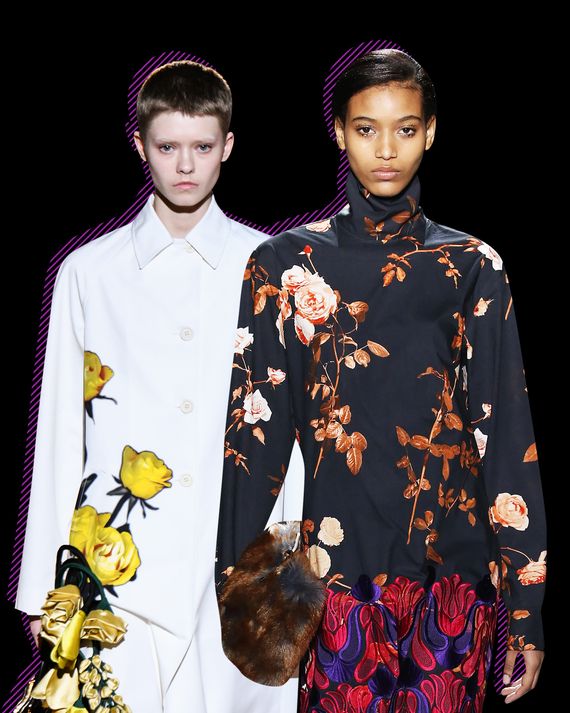
The most interesting collections this season swing between romance and paranoia, the key elements being extravagant flower prints and austere gray suiting that verges on a Cold War uniform. For many people, those two emotions — intense excitement and fear — define the weirdness of the present.
Miuccia Prada, fashion’s resident anthropologist, was the first to explore this duality a week ago with dark, tersely belted pantsuits, military jackets, and rose-splashed dresses and, if you look at Marc Jacobs’s collection, he too had a striking number of flower prints, some blunted by the stark lines of his tweed capes. Jack McCollough and Lazaro Hernandez of Proenza Schouler offered pantsuits in sturdy moleskin and coats with an extra layer of denim or leather that made them appear armored.
Yesterday, Dries van Noten opened his show in the concrete cellar of the Palais de Tokyo with charcoal pantsuits, coats and puffers, and then sent out dresses and satin jackets in icy pastels printed with long-stemmed roses, not unlike Prada’s.
It’s a fluke that van Noten and Prada landed on the same subject, though the results are not all that similar. Last September, van Noten and some assistants photographed flowers in his garden near Antwerp. “The idea was so simple and straightforward that in the beginning I said to myself, ‘You can’t do that that,’” van Noten said backstage. “Because you can’t just take a walk in the garden on a Saturday and have a collection.”
By then, some blooms were fading or covered in black spots, but he wanted the imperfection. And roses weren’t his only subject; he also shot salvia, delphinium, dahlias, and Japanese maple leaves — all against a board so that the shadow made by a flower could be reproduced as well. He then printed the images on cloth. More complicated still was the process of placing a printed bloom or a spray of maple leaves on a skirt or, say, the shoulder of a jacket, the rest of which would be in a solid hue of the same fabric.
Because the colors and the flowers leave you with a slight feeling of repulsion, this is one of van Noten’s most daring collections in awhile. The key dress style is a sliver that spills over the body, with long sleeves and a high neck. In some cases, the flowers are so intense they feel like an invasive plant. (I also noticed that in photos of the collection they appear to be three-dimensional, perhaps because of the shadow effect.) The colors — mauve, purple, aqua, yellow — are a strange blend of old-fashioned candy box and German Expressionism. And the slinky fit of the dresses, especially in jersey or layers of chiffon, along with the cold minimalism of some of the separates, adds to that off-putting sense.
The Prada rose dresses are easy to love; van Noten’s send out deliberately mixed signals. Are they beautiful? Or a little campy? Are they sweet? Or erotic? I love that he created a feminine collection that can’t be so easily tied with a bow, and my guess is many other people will, too.
Although van Noten’s gray pinstriped pantsuits and coats provided a stark contrast to his garden imagery, and could be read as an effort to retreat into the safety of a uniform, it must be said that the designs were fairly conventional. That’s not the case with John Galliano’s tailoring at Maison Margiela.
If you followed Galliano’s explosive couture show in January, in which colors and trimmings seemed to have been applied by a centrifuge, you might expect a turn toward sober for ready-to-wear. Although the collection included some deconstructed pieces — what looked like trousers turned upside down or possibly two portions of a suit jacket converted to a shrug, with basting thread still intact — the most arresting looks were constructed.
This has been a strong season for suits and classically masculine coats, but inevitably Galliano’s details set Maison Margiela apart from the pack. One slim wool coat came with raglan shoulders and sleeves in knitted wool. A jacket and trouser combination — like the one worn by Kasper Grzelak — might have a belted waist, or somewhat wider sleeves. In other words, none of his modifications to the classic style of a suit or a coat felt superfluous.
In fact, the more I think about Galliano’s current tailoring — especially in the first dozen or so looks — the more I am convinced that its strength lies in it being completely gender-fluid. To be sure, he makes that case explicitly by using male, female, and trans models, but the proof is also in the extraordinary attention to design, the small but knowing adjustments of cut and the implacably drab materials that are the equivalent of a whisper. Of course you would feel armored in those clothes, but not for the usual reasons.








